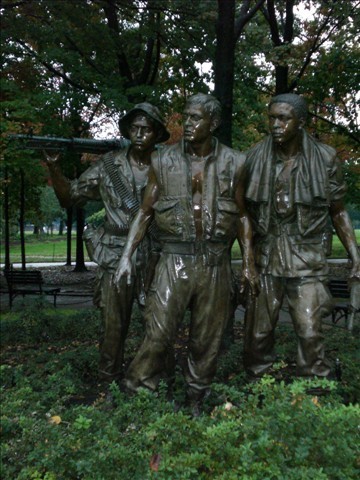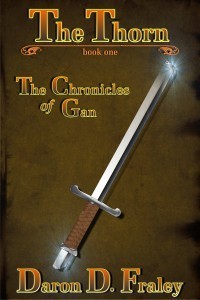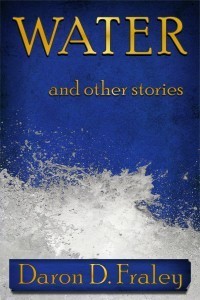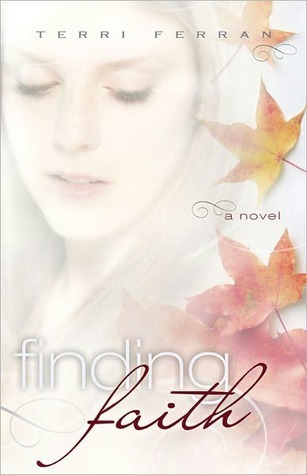A.L. Sowards's Blog, page 14
November 19, 2012
Remembrance Day
Last weekend a good friend went to Gettysburg, Pennsylvania, for their Remembrance Day activities. She posted these pictures on facebook, and with her permission, I’m reposting them (with her descriptions) below. I know I usually stick with WWII history, but today we’ll go a little further back in time, to the American Civil War.
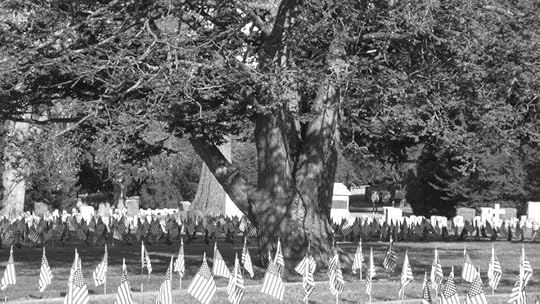
Each year on the Saturday closest to Nov 19, Gettysburg has Remembrance Day (Lincoln gave the Gettysburg Address on Nov 19). It is a chance to remember the battle, the war, and the cost of freedom. Norwich University hosts a short (2-3 mile) walking battlefield tour ending at the National Cemetery where we place flags on graves.
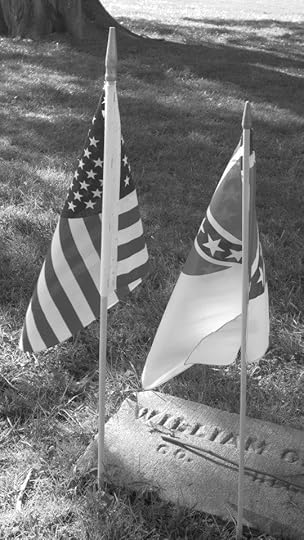
The interior section of the cemetery is where they buried many of the Federal troops killed during the Battle of Gettysburg 149 (!) years ago. As time has passed they’ve found that some of those buried were probably Confederate troops so you’ll occasionally come across something like this where you have a USA & a CSA flag side by side.
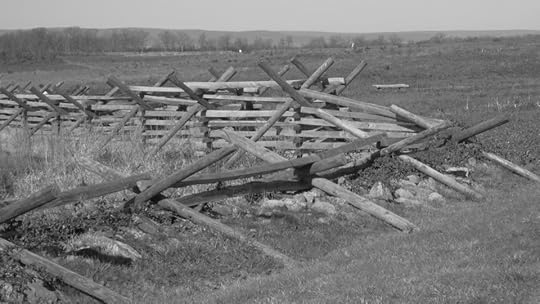
I’ve gone several years on these tours with Norwich & every time I am struck by the fencing as we walk the park, esp near the “high water mark.”

Honestly, aren’t these angles fun? On a more serious note, it is easy to see why people would get caught at the fences when trying to advance across the fields.
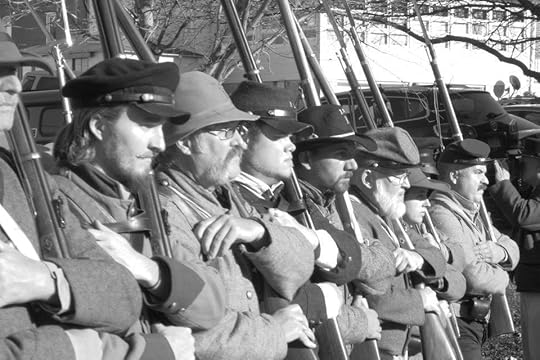
After the tour we go to the main street for the Remembrance Day Parade. Hundreds of re-enactors participate each year, their last hurrah for the season.
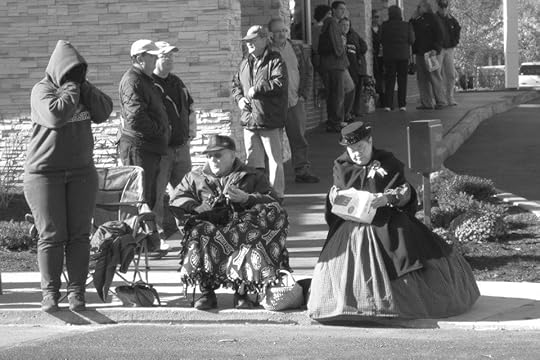
Not all of the costumed march. Others stand on the sidelines & cheer. This juxtaposition made me smile – the woman in her period clothes holding a McDonald’s bag. Most come in Civil War era clothing but we did see a Teddy Roosevelt, a couple of dough boys, & several WWII airborne infantry.
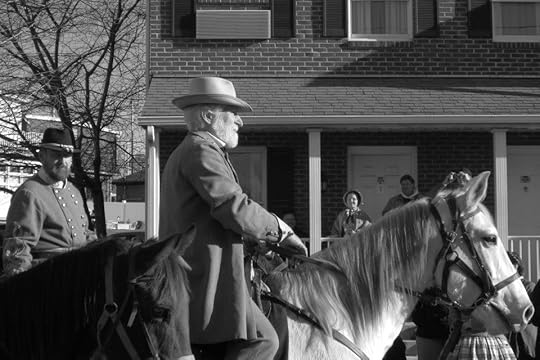
I didn’t get a picture of him but you always have a Lincoln & a General Lee. Both sides are represented during the day’s festivities although I failed to get pictures of the Federal troops as I was warming up indoors when they went by, although I could see them through windows.

The re-enactors get to pick their own rank so you get a disproportionate number of high ranking officers to enlisted. 
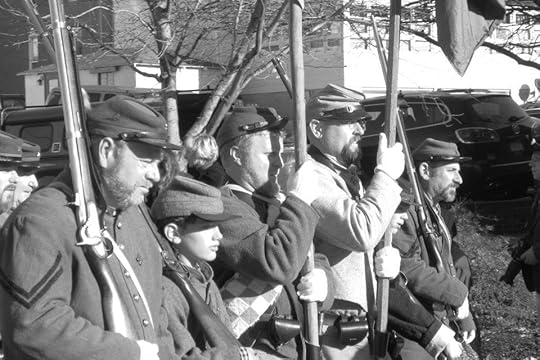
Many of the re-enactors are young…

Very young!
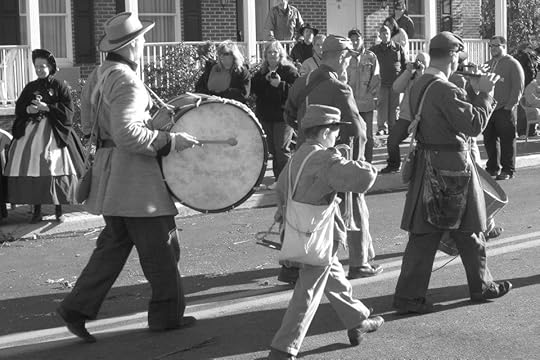
Most of the younger re-enactors are pipests,

or they’re drummer boys.

Black & white photography just felt right for the time period they are portraying
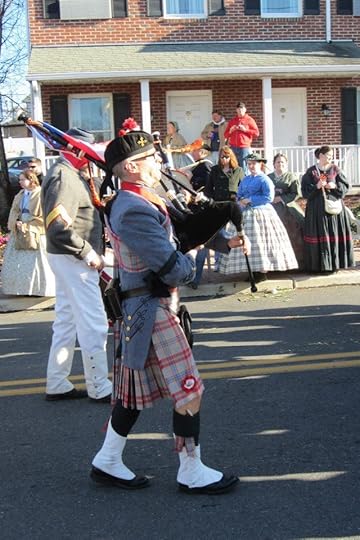
But this bag pipest’s costume needed to be seen in color. The traditional kilt, flashers, scarf, & tam paired with his gray coat.

A few of the southern flags seen throughout the parade.
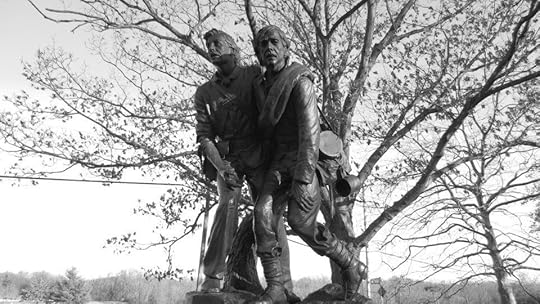
I love this statue! It always reminds me of the stories I’ve read, or been told, of how you keep fighting even though you’re exhausted because you don’t want to let the “brother” fighting beside you down.

For the last few years at the end of the day I’ve been able to help set up & light the lumanaries in the cemetery. Pictures don’t do it justice but it is a very powerful, moving sight.
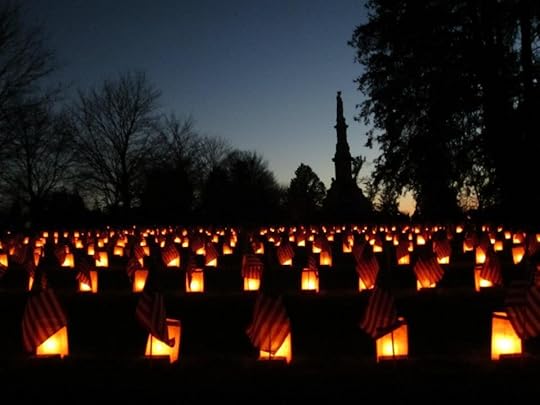
This year I was assigned to work on one of the three “unknown” sections. There are hundreds of unknowns buried here as they didn’t have dog tags. The assumption was because you served with men you grew up with they’d be able to identifiy you, but that was often not the case.
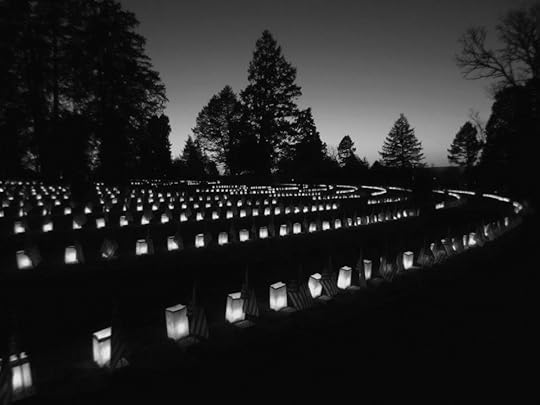
To give you some idea of the number of soldiers buried here just from the Battle of Gettysburg, this is maybe 1/3 of the lumarnies.

Keep in mind that this is just a small percentage of those killed during the battle as most of the dead were shipped home. It is always a forceful reminder that freedom isn’t free.
Thank you to my friend (she prefers not to be named) for allowing me to share this album with my blog readers. This Thanksgiving week, I am very grateful for all the sacrifices others have made so that I can have the blessings of freedom.
Filed under: History, Holidays


November 11, 2012
Happy Veteran’s Day!
I’m having this post at 11 in the morning, French time (at least according to the time zone chart I found online). Why? Because Veteran’s Day used to be Armistice Day, a day to remember the cease-fire on the western front during WWI. The cease-fire took place on the eleventh hour of the eleventh day of the eleventh month, 1918. The day was later expanded to commemorate all veterans who have fought for our country’s freedom. So this Veteran’s Day, I hope you’ll thank a veteran, or pray for our current servicemen and women. We owe them a great deal of gratitude.
If any veterans happen to read this blog: THANK YOU FOR YOUR SERVICE AND SACRIFICE.
Filed under: History, Holidays


November 7, 2012
The Next Big Thing Blog Hop, week 20
There are the books everyone talks about: Twilight, Hunger Games, Fifty Shades of Gray. But what about all those books written by people you’ve never heard of? Some of them are treasures, just waiting to be found, and that’s what this blog hop is all about: the books you might not have heard about, but that you might end up loving.
This blog hop is like a game of tag. One author posts and tags a few other authors who link back to their website the next week and tag some other authors. If you follow the blog hop long enough, you’re bound to find some books you’ll love! Maybe you’ll even discover a book that ends up being the next big thing.
I’d like to thank fellow author Michelle Renea Anderson for tagging me to participate. You can find more about Michelle on her blog, Amazon author page, or by following her on twitter (@MichelleRAnders). Her book, Shelby’s Plan, is available for purchase Amazon.
This blog hop includes ten questions to help you learn more about an author’s current work in progress, so here’s a little info about my next book:
1: What is the working title of your book?
After going through the publication process with my first book, Espionage, I decided never to get attached to a title again. So I usually refer to it as book two, but I do have a list of about ten title suggestions. The publisher might pick one of them, or they might pick something else. I’m keeping my suggestions quiet, because there’s a good chance the publisher will come up with something completely different (that’s what happened with Espionage).
2: Where did the idea come from for the book?
I was doing research on WWII Yugoslavia and found some information about the oil fields in Romania (planes returning from bombing missions in Romania often crashed in Yugoslavia). It got me thinking about Hitler’s largest oil supply and it went from there.
3: What genre does your book fall under?
historical suspense/action/LDS fiction
4: Which actors would you choose to play your characters in a movie rendition?
This is a fun question to answer. There are a few characters in my book that I got lazy with when I was describing them, so they’ve always looked like actors: I’d want Rupert Grint to play Private Daniel Fisher and Wesley Idol from P-90 Kenpo X (a work-out dvd) to play Major Wesley Baker, because that’s who those characters have always looked like in my head. And Tom Cruise for Colonel Eliade.
Then there are the characters who don’t look exactly like any of the actors I’ve seen (maybe I should watch more movies), but these actors might work:
Genevieve Olivier: Emmy Rossum
Iuliana Ionescu: Rachel Weisz
James Nelson: Jude Law
Krzysztof Zielinski: Sam Clafin or Matthew Lewis
Sergeant Moretti: Liev Schreiber
Constantin Condreanu: James Marsden
But what about my main character, Peter Eddy? Still not sure who I’d want to play him. Preferably an American actor, about five foot ten inches, with brown hair, brown eyes, and “girlie-thick” eyelashes. Those of you who’ve read Espionage, do you have any suggestions?
I realize if all the names on this list were in a single cast, there would be no money left for special effects. I’m not stuck on any of these actors—I’m sure there are many relatively unknown actors who could do a great job with these roles.
5: What is the one-sentence synopsis of your book?
Peter Eddy was told his commando team’s assignment was to monitor Nazi oil coming from Romania, but he wasn’t told the whole story, and not everyone on the team wants the mission to succeed.
6: Will your book be self-published or represented by an agency?
Neither. I work directly with my publisher, Covenant Communications.
7: How long did it take you to write the first draft of your manuscript?
About a year. I started pieces of it a couple years ago, but did the bulk of the first draft during 2011. Then I had to chop out roughly 20,000 words (more about that here), and that took about two months.
8: What other books would you compare this story to within your genre?
(Apology: I’ve answered this before and couldn’t come up with a different answer, so it’s a repeat from a previous post.) In the national market, books by Jack Higgins or Alistair MacLean. In the LDS market, books by Sandra Grey or Traci Hunter Abramson.
9: Who or What inspired you to write this book?
While swimming one day after I’d finished several drafts of the book that became Espionage, I started thinking about the characters. I’d planned on leaving them alone for a while, because they were kind of beat up by the end of the book. But then I thought more about the last year of WWII and came up with some new ideas.
10: What else about your book might pique the reader’s interest?
It’s the second book in a group of three with these characters during WWII, but you can pick it up and read it without having read Espionage. Readers often have general expectations for the second book in a trilogy: it will be darker than the first and end in a cliffhanger. That’s not the case with this book. There are some cliffhangers at the end of chapters, but the end of the book wraps up nicely (I save the next cliffhanger for the beginning of book three). And it’s not all that dark. Of the three books, I’d say it’s the least likely to make readers cry.
Here’s a list of authors who will be joining the hop for week 21 on November 14th. I hope you’ll visit their blogs next week and learn more about their books. Maybe one of them will become your new favorite author!
Stephanie Worlton
Stephanie’s book, Hope’s Journey, is available on Amazon. To learn more about Stephanie and her book please visit her blog, website, orFacebook page.
Charissa Stastny
Char writes a great blog, and her first book, Eyes of Light, is available on Amazon. You can connect with Char through her blog, Amazon author page, or Facebook page.
Rebecca Jamison
Rebecca has a blog, Amazon author page. and a Facebook page. You can purchase her first novel, Persuasion: A Latter-day Tale (yes, it’s based on the Jane Austen classic), through Amazon.
Kelly Nelson
When Kelly isn’t selling out the entire stock of her books at her local Costco (pretty cool, huh?), she can be found on her website, Amazon author page, Facebook page, or Twitter (@kellynelsonauth). Her debut novel, The Keeper’s Calling, is part of a series and can be purchased on Amazon.
Filed under: Book 2, Writing


October 23, 2012
How to cut out 16% of your manuscript and still like your novel
This spring I submitted novel number two to my publisher. They took a few months to look it over and have the evaluators analyze it, then got back to me this summer. Overall, they had a lot of good things to say, but they wanted the manuscript shorter. A lot shorter. Like 20,000 words shorter (roughly 60 pages).
I’ll admit, I panicked for a few seconds. How could I cut that much? I was so excited about my manuscript—how could I chop it without ruining it? But I quickly decided to go for it, because I like my publisher and I want to publish my second book with them. Since my second book includes characters from Espionage, I wanted to maintain the same feel and the same distribution power, and I could only get that from Covenant. So I went to work. And you know what? I think I could have added 20,000 words more quickly than I cut them. It was an interesting process. There are some things I’d love to add back in, but there are also a lot of things that needed to go, and now that they’re gone, I don’t miss them.
So if you ever find yourself in a similar situation, or if you’re just curious about how the writing process works, here’s how I did it (warning, I’m enjoying not having a word limit on this blog post, so it’s the longest I’ve ever written):
Casting call
One of the first things I did was eliminate a few characters (five, I think, but then I had to add someone else in, so I guess the net deletion was only four).
One of my characters spent some time in London. Originally she had a roommate. She probably still does, because she’s not rich enough to afford her own room, and housing in London during WWII was tight enough that she’d need to share, but the roommate wasn’t that important to the story, so she’s gone. Ditto the roommate’s love interest. The character had to figure out a few things on her own or from the book’s main character instead of the roommate, but overall, I think it’s a change for the better.
The main plot line of my manuscript revolves around a WWII commando team. Most commando teams of this type had 15 to 30 members. Originally, I went on the smaller end of that, 15, so I could stay historically accurate but have fewer characters for the reader to keep track of. I even had two of the commandos get injured or kicked off the team before they left for their mission, so it was eventually whittled down to a lucky 13. With the new version, I started off with thirteen. As a bonus (in terms of cutting words), I deleted the scene where one character was kicked off the team and shortened the scene where the other character got injured.
Cutting characters can be a little tricky. For example, I had one character get married when the team had weekend leave. I cut that out. Then I realized I needed the team to know something the character learned from his new bride. So I left the bride out, and had the clue come from a different team member’s girlfriend. Overall, it still reduced the word count, in a kind of roundabout way.
Take shortcuts
Remember that 13-member commando unit? I didn’t have enough words to bring them all fully to life. And that’s OK—some of the team members aren’t that important to the overall plot. I couldn’t get rid of all of them—I needed that many bodies. So while some of the commandos will (I hope) feel like real people, some of them aren’t all that fleshed out. To help readers keep track of them, I gave some of them distinguishing habits. (Confession: this was partially inspired by the movie Big Red One, where one of the squad members is always smoking a cigar, and another—Mark Hamill in a role other than Luke Skywalker—is always drawing, at least when he’s not in combat.) So one member of my commando team pops his knuckles, another chews gum, several of them smoke, and one is an artist with a sketchpad. If a reader doesn’t remember that Private David Mitchell is from Saskatchewan, went to college on a track scholarship, has gray-blue eyes, is a skilled sniper, and has a girlfriend named Sally, maybe they’ll at least remember he’s the guy always chewing gum.
Find your favorites
When you’re cutting a ton of words (more than 10% of your manuscript), there’s a good chance you’re going to have to eliminate or drastically reduce a few scenes. You don’t want to cut the best part, so as you begin cutting, think about what in your manuscript is most worth preserving.
For me, I really loved my initial action sequence. And I really loved the two missions my main characters are involved in that lead up to the climaxes of their stories. Frankly, once my characters were on location, it would be hard to do much plot cutting, because in both cases event A led to event B which led to event C, etc. So that left me with the middle: when my characters were recovering from the beginning and getting set up for the bulk of the story. That’s where most of my cutting took place.
Recovery: cut from two chapters to one. Training: reduced. Leave: condensed. It’s not that I didn’t like the middle, I just liked the beginning and the end better.
Take some hints from Hollywood
While we’re talking about plot changes, here’s something to consider: can things that happen sequentially happen concurrently instead?
Take The Hunt For Red October, by Tom Clancy. It’s been a while since I read the book. But if I remember right (warning, mild plot spoiler ahead), once Jack Ryan is on the Red October, he and the other characters have to deal with a threat on the submarine, and then with a threat outside the submarine. They deal with one, and then they deal with the other.
Now jump to the movie version. When I saw the movie for the first time, I was actually impressed with how closely it followed the book. But in the movie, while Ryan and Ramius are dealing with the threat on the sub, Mancuso and the others are dealing with the threat outside the sub, all at the same time.
This technique is great for books with multiple point-of-view characters, or for books with multiple antagonists. Think about Return of the Jedi, where the action bounces from the rebel team on the forest moon of Endor, to the inside of the Death Star where Luke is confronting the emperor and Darth Vader, to the space battle between the Imperial and Rebel fleets. We don’t see any of the three events in entirety—we don’t need to. Instead, we get to see the highlights–the most exciting parts–and we never get bored.
Did I do this with my book? Yes. Originally, I had a group of characters dealing with “bad guys A”. They took care of them, then they were attacked by “bad guys B” and had to fight them. Now they have two sets of bad guys to deal with at once. Did it cut out some words? Not as many as I had hoped. Still, it made for a more exciting scene, so I’m glad I made the change, and it did reduce the word count a little bit.
What genre are you?
When making drastic word-count-cuts, you’re probably going to have to leave out some details. But which ones? As you decide, ask yourself why your readers are picking up your books. What do they expect from you? If you write romance, you won’t want to cut much from the kissing scenes. If you’re known for beautiful descriptions of the scenery, than you’d better leave your description of the sunrise as is.
I had to tell myself over and over again that I’m writing a thriller, not a travelogue. I usually don’t spend much time describing the scenery anyway; now I spend even less time. And I don’t write fashion fiction. So my characters wear clothing. And if it’s important to the plot, I might use a few words to describe it. If not, my readers will just have to assume no one is walking around in the nude.
Some details are fun, but unnecessary. For example, in one scene my communications genius was snacking on a D ration bar. In a roundabout way, it’s related to the plot. My characters had to eat, or they wouldn’t have enough energy to fight Nazis, and eventually they’d die. But this was a detail I could leave out, so I did.
I’ll be honest, deleting details was often hard for me. I write historical thrillers, so I’m trying to satisfy two types of readers: adrenaline junkies and history buffs. I didn’t cut out all my historical details, but I went through and asked myself if they were relevant to the plot. Some of them were, so they’re still in the manuscript. I think most readers will still learn something new about WWII.
There are a few things I had to cut or condense that I’d still like to shove back in. For example, my book has a briefing scene, when the commando team is told what their mission is. Originally, the guy giving the briefing summarized what had occurred in their target area up to that point in the war. It seemed like a logical way for the briefing to unfold, and I felt a few details about previous (historical) missions that ended in disaster helped raise the stakes and set a tense tone. I didn’t want to get rid of the details, but in the end, I did. I still mention some of the history, but in a few sentences instead of a few paragraphs.
Here are a couple things that made it easier to cut out details: I’m working on another book after this one with several of the same characters. So when I had to cut back story, I told myself I might fit it into the next book. I also have a blog. When I had to cut out something really cool that I did a lot of research on, I told myself I could make it into a blog post. That way my research wouldn’t go to waste, nor would it be unnecessarily inflating my word count.
Say what?
As I went through my revisions, I noticed a pattern. Some areas were consistently easier to cut. I could often start a scene a few paragraphs later than I did, or end it a little earlier. I would turn a few paragraphs into a few sentences, explain how my characters had arrived where they were, and then move more quickly to the important part of the scene.
This was especially true with dialogue. Sure, characters might beat around the bush in real life, but why not get directly to the point? Does the last reply really need to be written, or can the reader figure out how a conversation is going without seeing it in its entirety? Can fewer exchanges still get the point across?
A word of caution: if all of your characters always use as few words as possible to say something, they might all start sounding alike. So cut the dialogue with caution. Some characters might be a little wordy—if so, I’d recommend finding a different place to cut so you can keep your characters sounding right.
Omit needless words
OK, I stole that subtitle from Strunk and White. But it’s huge. If you need to cut a ton of words, you’re going to have to go through each sentence and see if you can write it in a more concise manner. Here are a few examples.
Why have your characters stand up or sit down when they can simply stand or sit? Why have a character hear the sound of artillery booming in the distance when they can just as easily hear artillery booming in the distance?
Do a search for words such as: started, tried, began, decided. Often, they come in combination with other verbs. Sometimes it affects the meaning, but often the extra word can be deleted.
I also did a search for words that end in “ly.” You’d be surprised how many adjectives and adverbs you can eliminate. I’d also recommend searching for very. It’s usually unnecessary.
Another word that’s often not needed: that. Do a search for it. If you can read the sentence without it, leave it out.
I my manuscript I often said things like “about twenty-five yards away.” After all, it’s not like my characters are walking around with measuring tapes. So when they see something, they’re making a good guess. They don’t really know, not exactly. I might have a point, but few readers will complain if I use “twenty-five yards” or “a mile” instead of “about twenty-five yards” or “about a mile.” All my characters now have super-human distance-judging abilities.
Other words I found I was overusing: only, despite, just, then, and even though. Other writers may have different candidates for deletion, but that’s a good place to start. I also found it was easier to delete extra words when I looked at them in isolation. When I read my story chronologically, I had a tendency to get into the “if it’s not broke, don’t fix it” mentality. When I did a search for a specific word, it was easier to ask “is this word really needed?”
Get nit-picky
This is kind of a continuation of “omit needless words,” but it involves things that go beyond style. For example, I have a list of everyone on the commando team at the beginning of my book, just in case people forget who’s who. Originally I had the ages listed. But do the ages really matter? I decided they didn’t, so I cut that information from the list. It only saved 26 words, but every word counts.
Here’s a useful thing to say to yourself when you’re in a word crunch: contractions are your friends. Really, anywhere you can, use them. Don’t ruin your style or have purposely formal characters become informal, but look into replacing “did not” with “didn’t” and “he had” with “he’d”. Do it often enough, and you’ll notice a difference in the word count. Same thing with compound or hyphenated words: use them if they’re correct.
I had a lieutenant colonel in my book. According to my slightly-outdated Chicago Manual of Style, it’s written like this: lieutenant colonel (two words), not like this: lieutenant-colonel (one-word). So I gave my character a promotion and made him a full colonel. It’s probably the worst reason for a promotion since Catch Twenty-two, but it eliminated a few worlds.
Inch by Inch
Ultimately, you may have to go through each sentence and each paragraph and ask yourself why it’s there. Is it necessary to the plot? Does it reveal something important about a character? Does it help your reader see the setting? . . . Or can it go?
Cutting out words is tedious. It can be discouraging to go through a chapter and rewrite half the sentences so they’re more concise, only to hit the word count and find you’ve eliminated a mere 100 words. But 100 words a chapter, times however many chapters in your book, is significant progress.
So next time you have to cut down the size of your novel, save a copy of the original (it’s easier to cut words when you know they’re not completely gone), roll up your sleeves, and become intimately acquainted with the delete and backspace keys. Happy cutting!
Filed under: Book 2, Writing


October 15, 2012
Research Find: Why you shouldn’t tell the newspapers if you’re breaking someone’s code or tracking their satellite phone
In 1927, the government of Great Britain was looking for a reason to break off diplomatic relations with the Soviet Union. They had plenty of reason—for one, the staff from the Soviet embassy in Great Britain was involved in espionage. Proof could be found in several diplomatic messages that the British had intercepted and decrypted. The British released the decoded messages and published them in The Times. Thus, the reason for the break was justified publicly.
The Soviet Union promptly dropped their diplomatic code and switched to using one-time pads. The British were unable to break any Soviet codes for the next twenty years. In the meanwhile, several very successful Soviet spies were able to steal all sorts of British secrets (if you’re looking for an example, google the Cambridge spy ring).
This bit of history reminded me about a more recent event. Osama Bin Laden used to have a satellite phone (fourteen, fifteen years ago). He used it. The CIA (or NSA) tracked it. In 1998, the story leaked and was printed in a major US newspaper. Bin Laden stopped using his satellite phone. The US government could no longer listen in to his phone calls. I think everyone remembers what Bin Laden went on to do in the years between 1998 and his death in 2011.
Before posting this blog, I looked up the Bin Laden story, just to make sure I had it right. Turns out the way I remember it isn’t completely accurate. When the Washington Times reported that Bin Laden had a satellite phone, it didn’t say the US was tracking it, and it wasn’t the first time word had gotten round about Bin Laden’s phone. Bin Laden did dramatically decrease how often he used his phone after the Washington Times story, but at about the same time he was almost killed by a US missile strike, which may have been a larger factor than the article. The LA Times was the first paper to report that the government was actually tracking the satellite phone, and after that the calls dropped off completely.
So what was the point of this post? Just to say that some things never change—intelligence successes are usually secret. And if they become publicly known, they often change into intelligence failures. Also, it seems that anything involving George W. Bush is still controversial. I wonder how many decades it will take for that to change?
Filed under: History, Research Finds


October 5, 2012
Author Interview with Kate Palmer
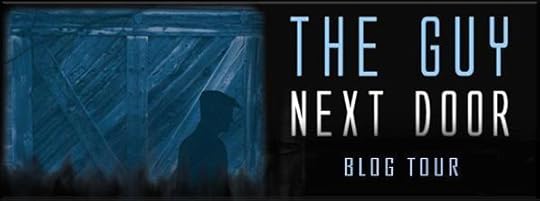 Today I’m part of a blog tour for Kate Palmer’s debut novel, The Guy Next Door. Kate is an elementary school teacher turned fulltime mom, with six children, and she keeps a blog with information about food, life in the country, and, of course, reading and writing. She’ll be signing copies of her book at the Logan Deseret Book this weekend for Ladies’ night for any readers living nearby. Keep reading to the end to find out how to win a copy of The Guy Next Door, some candy (Junior Mints–the main character’s favorite), and a recipe for lemon chicken.
Today I’m part of a blog tour for Kate Palmer’s debut novel, The Guy Next Door. Kate is an elementary school teacher turned fulltime mom, with six children, and she keeps a blog with information about food, life in the country, and, of course, reading and writing. She’ll be signing copies of her book at the Logan Deseret Book this weekend for Ladies’ night for any readers living nearby. Keep reading to the end to find out how to win a copy of The Guy Next Door, some candy (Junior Mints–the main character’s favorite), and a recipe for lemon chicken.
Here’s the book’s synopsis:
On the surface, Eva Black’s life seems practically perfect. The small-town kindergarten teacher is set to wed ambitious lawyer Sean Langley, and their plans for a dream wedding are well underway. Eva accepts that she will soon live life in the spotlight as a member of the prestigious Langley family, but can she overlook her fiancé’s tendency to dominate the details of her life and push the limits of her standards?
Mere weeks before the wedding, Eva is thrown into a traumatic, life-changing event that changes her view of family commitment and creates a sharp contrast between her ideals and Sean’s. With her engagement to Sean in jeopardy, Eva finds herself relying on the support and encouragement of Peter, her kind and attentive next-door neighbor. Faced with a choice between her penitent fiancé and the increasingly mysterious Peter, Eva is unprepared for the consequences—and peril—that come with her decision.
If you were stuck in an airport with nothing else to read, would you rather have a copy of Twilight or Hunger Games?
I loved both of these books so this is a really tough question. I think Twilight would win out because it’s a stronger romance.
Favorite quote:
I am doing a great work, so that I cannot come down . . . (Nehemiah 6:3) This is something I tell myself when I’m too busy with my family to get any writing done.
That is a great scripture. And it can be challenging to find the right balance of being a mom and being an author, so what a wonderful way to remind yourself what is most important.
Favorite Shakespeare play:
Taming of the Shrew
What household chore do you have the hardest time keeping up with?
Laundry, specifically the whites. My family knows that whenever I have a baby (and for at least six months after), they can find clean socks, underwear, and towels piled in a large basket on the laundry room floor. Everyone paws through it to find what they need. Daily.
Hey, as long as it’s clean!
When did you start writing?
I started writing fiction four years ago. I never even considered it before then.
How do you come up with ideas for your books?
I take events from my family history and ask how could this happen today. What’s the modern version of this story? Then I like to combine that with something from the news that interests me.
What is your favorite thing about writing?
I love the flutter of excitement I get when I’m drafting and my daily writing time is approaching. It seems kind of crazy since I’m the one writing the story, but I can’t wait to get back to working on the manuscript to see what happens.
I know exactly what you’re talking about!
You can learn more about Kate on her blog (and pick up some ideas for dinner) or facebook page.
And if you’d like to win a copy of the book, you can get entries by subscribing to her blog, liking her facebook page, tweeting about the giveaway, or leaving a comment on any of the blog posts on the tour (full schedule available at The Book Bug). It’s a Rafflecopter giveaway, so click the link and have at it (US addresses only, must be at least 13 years old to enter, giveaway goes until November 2nd).
Here’s the book trailer:

Filed under: Author Interviews


October 2, 2012
A Catch-up Interview and Some Other Stuff
One of my blogging friends tagged me with a few blog awards (her blog is called Joy In the Moments). The first two were in June (or May—I forget because it’s been so long), and I’m only now getting around to answering them. So Char, this post’s for you (and for anyone else who’s interested)!
During this post, I’m going to be talking about my second book. It’s completed and turned in to the publisher. I’m still referring to it at book two because I don’t know what the final title will be.
1. Which genre best describes your current WIP?
Historical Suspense
2. Who do you consider the audience?
People who are too old to play with plastic army men.
The book is written for the LDS market, and should appeal to both adrenaline junkies and history buffs.
3. How did the idea come to you?
I knew where I wanted my characters to be in book three (Yugoslavia), and as I was doing research, I found out that a lot of Allied airmen crashed in Yugoslavia on their way home from Romania. So I though my commando team could crash in Yugoslavia on their way back from a mission in Romania. I ended up taking out the plane crash, but the commando mission in Romania stuck.
4. Are you an organized outliner or a pantser when you write?
I’m kind of a mix. I start with some ideas in my head and write the scenes that are vivid in my mind. Then I go back and figure out the rest of it. But sometimes I get stuck, and that’s when I start outlining. I’m noticing a pattern though—each book I write has more and more of an outline, and each book I write (so far) is coming a little more quickly. I suspect there’s a correlation between the outlining and the writing speed, so I think I’m turning into an outliner.
5. Is this book part of a series/sequel or standalone?
The book being discussed is the second in a series. All the books can be read alone, but involve the same characters. The book I’m currently writing is the third book in the series.
6. Did your research lead you to new twists or scenes for the story?
Yes. You can see the answer to question #3 for one example. The other biggest one would be kind of a plot spoiler if I mentioned it, so I won’t. I feel I’m constantly trying to manipulate my plots so they involve a historic event or looking for the perfect historical event to fit within my plot.
In book two, I did some research on the German army in Marseilles, France, and with that information I created a character who is a decent man, just on the wrong side of the war. I tried to convey the feelings a German officer in Marseilles would have felt when Hitler ordered them to hold out at all costs, even when they lacked the manpower and supplies to do so.
7. Some agents suggest comparing your work to that of a published author. Can you think of a good comparison for yours?
On the national market, I’d say Jack Higgins or Alistair MacLean. In the LDS market, Sandra Grey or Traci Hunter Abramson (except my books take place during WWII and Traci’s take place during the present day).
8. Who is your greatest cheerleader/supporter for your writing?
One of my little sisters. She had a degree in military history and grew up reading all the same novels about WWII guerillas. She’s one of my test readers, and few things make me happier than seeing her comments that say what I’ve written jives with her research, and that she had to read it twice because the first time through she was too caught up in the story to notice typos or stop and make comments.
9. Seated next to you on a plane is one of your dream agents. Do you have a 3-sentence description of your WIP ready to pitch?
Since I’m happy with my publisher, I’m not really looking for an agent on this project. But if I was, I might say something like: My book is suspenseful enough to make you bite your nails, romantic enough to make you sigh, and deals with aspects of WWII that haven’t been overdone—the invasion of Southern France and the situation in Romania, both during the summer of 1944. It’s about friendship and trust and duty and unintended consequences. It also kept most of my test readers up well past their bedtimes.
10. Book covers and ads often carry a short excerpt from the story. Would you share your choice with your readers?
“Give the signal,” Peter said.
Quill let out a bird call. It wasn’t very life-like, but it would warn the team to move away from the bridge so they wouldn’t be injured when it exploded.
Seconds later, huge floodlights glared through the night and settled right on Peter and Quill. A dark-haired junior officer who looked like he could have just strolled off a movie set appeared. “Hands up,” he said in slightly accented English, pointing his rifle at Peter. Quill obeyed. Peter took a half-second to calculate—he knew he could blow the bridge before the other man’s finger pulled the trigger. So Peter slammed the lever down as hard as he could.
11. When your book is published, how will you celebrate?
I’ll go to the local Seagull book store and smile when I see my book on display. They give whatever is new from Covenant prominent placement, and it’s a thrill to walk into the bookstore and see your book front and center.
OK, now I’m moving on to the other tags. The Lucky 7 tag works this way: You go to page 7 or 77 in your current manuscript, go to line 7, and post the next seven sentences/lines. (I’m not doing exactly seven lines, but close. Also, keep in mind that these lines may change after my editor looks at them, and the page numbers on my word doc won’t line up with the final printed text.)
Here’s an excerpt from the seventh page of the manuscript:
“And these are your parents?” He pointed to the family picture. Genevieve nodded, feeling a new jolt of pain run through the left side of her body as she moved. That side had hit the wall the hardest. She held the bottom of her rib cage with her forearm, trying to hold back the spread of pain. “And are they also dead, mademoiselle?”
“ Yes.” Her mother had died when she was three, her father when she was thirteen.
“ Why, Mademoiselle Olivier, you appear to be completely alone in this world. How pathetic.” With those words, Tschirner tossed all three pictures across the barn. The glass shattered and Genevieve automatically moved to retrieve them. She only moved an inch before Siebert seized her arms and jerked her to her feet.
And here’s part of page seventy-seven:
When the meal was finished, Nelson wandered over to Luke and handed him a glass of milk.
“ What’s this for?” Luke frowned at the glass.
“Tears, then, for babes—blows and revenge for me! And milk for a homesick American ninny.”
“ Leave him alone,” Peter said.
“ Of course. Please accept my apology, Mr. Lucaciu.” Nelson turned from Luke and smiled at Peter. “I’m sure you have never been homesick, Lieutenant Eddy. What is there to miss about a poverty-ridden farm in the middle of Idaho?”
The last catch-up tag is the Reader Appreciation Award. I’m supposed to tell something about myself. You can find a lot about me on my “about A.L.” page, but here’s most of the bio I’m hoping to put in the back of book two:
A.L. Sowards grew up in Moses Lake, Washington, then came to Utah to attend BYU and ended up staying. She wrote most of [whatever book two ends up being called] while her toddler twins were sleeping and did most of the revisions while they were supposed to be sleeping, but were really using their crib mattresses as trampolines.
So Char, better late than never, right? And anyone else who’s read the entire post—thanks for sticking around! I think I’m supposed to tag someone else—so if anyone wants to be tagged, let me know and I’ll add you in.
Filed under: Book 2, Writing


September 19, 2012
A Brief Ode to a Couple Inanimate Objects
I injured my back on Saturday. I wasn’t even doing anything cool. I was just dragging a stack of little chairs from one end of the church to the other so the children in our congregation could practice the program they were doing the following day (if you were wondering, the ten children in our smaller-than-normal primary did an excellent job).
Since then I’ve been spending a lot of time lying on the couch with my legs propped up on the armrest, and I’ve developed profound gratitude for two inanimate objects.
First, my ice pack. This one has gel in it, so it doesn’t freeze solid. Rather than lying on a chunk of hard ice, I can lay on a nice cold object that molds to fit my back. It also beats bags of frozen peas. Really, if you don’t have a gel ice pack, you should get one.
Second, my kindle. The best part of being injured is getting to read. I finished a research book and read an amazing nonfiction book that wasn’t related to my current writing project and then started a novel. And when my toddlers want me to take a break and read board books to them (does anyone besides me find most board books boring?) I can find my place again in seconds. I’m not going to tell everyone to get a kindle, but hey, make time to read something.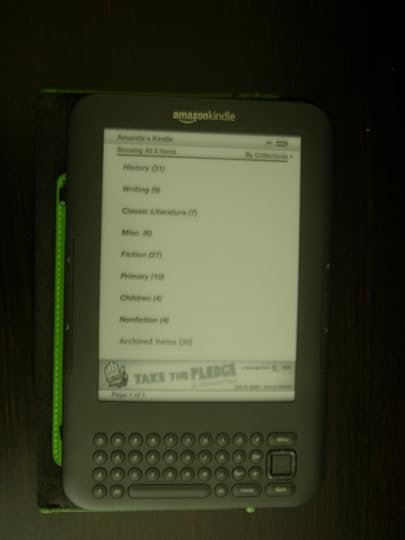
Now you’ll have to excuse me. I need to go lay on the couch with my ice pack and read my kindle.
Filed under: Reading


September 4, 2012
Author Interview with Daron Fraley
 Today I’m interviewing another friend from my writer’s group, Daron Fraley. He has a few books out (some of them free–more details on that after the interview). I was a test reader for his most recent book, Thirty-Six, and it’s a fun read! Daron does a great job of creating realistic, likeable characters and weaving in Biblical lore, then adding some adventure to keep those pages turning. It’s a cool book, and it’s part of a cool project that will involve several authors telling stories about an ancient Jewish Legend. Here’s a hint of what the first book’s about:
Today I’m interviewing another friend from my writer’s group, Daron Fraley. He has a few books out (some of them free–more details on that after the interview). I was a test reader for his most recent book, Thirty-Six, and it’s a fun read! Daron does a great job of creating realistic, likeable characters and weaving in Biblical lore, then adding some adventure to keep those pages turning. It’s a cool book, and it’s part of a cool project that will involve several authors telling stories about an ancient Jewish Legend. Here’s a hint of what the first book’s about:
Three things Aaron Cohen never intended:
To purchase an ancient, holy relic.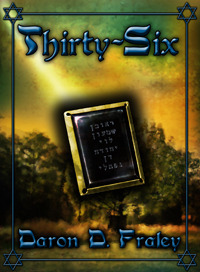
To encourage the mysterious stalker.
To fall for Mandie.
But he did. And if he doesn’t get to her
in time, she will die.
And now, the interview:
List five movies you LOVE :
Ben Hur, Master and Commander, The Ten Commandments, Last of the Mohicans, The Lord of the Rings series.
My favorite book used to be Return of the King, by J.R.R Tolkien. That may seem cliché to some, but I loved it for different reasons than most people, I am sure. I was enthralled by the transformation of Aragorn, specifically how he comes to accept his role as king. One of the biggest moments for me was when he finds the young sapling tree, sprouted from a fruit of the White Tree, and replants it in the stead of the withered tree. It blossoms as a sign of the end of the Great Darkness. Anyone who knows the 22nd chapter of Revelation will see the parallel here.
But my new favorite book is The Way of Kings by Brandon Sanderson. I must have some fascination with kings or something.
If you were stuck in an airport with nothing else to read, would you rather have a copy of Twilight or Hunger Games ?
Is this a trick question?
Item(s) you’re willing to splurge on:
Books. My most expensive book: American Dictionary of the English Language, Noah Webster, 1828 (reprinted) edition.
Writing advice you’d give to others?
Read. Read cool stuff. Read fantasy. Make your mind explore the new worlds found in Sci-Fi and Fantasy so that you can see how to weave politics and economy and setting and religion and adventure all together. Then go write romance. That’s where the money is.
Elementary school, I think. I vaguely remember a stapled book with colored pages. Or I’m stealing that memory from my kids.
What are you working on now?
I have started another book in the Thirty-Six series, tentatively called The Signets of Darius, and have the sequel to The Thorn, called Heaven’s Garden, about two-thirds done. I hope to finish that one by Christmas.
What type of readers would like your book?
My current book, I assume? Thirty-Six was written with a general audience in mind, but with hopes that there is enough romance in the story to grab the interest of women readers. I would consider it to be a clean read: no sex, no profanity, no gory violence. But people do die. If I had to give it a movie rating, it would be PG, or PG-13.
You can learn more about Daron on his blog and more about the Thirty-Six project here. And do you want some free books? You can download the kindle versions of Water and Other Stories and The Thorn from Amazon, and goodreads members can enter a giveaway for the chance to win a the paperback version of Thirty-Six. And rumor has it the eBook version of Thirty-Six will be free again sometime in September. You can follow Daron’s blog or follow him on twitter (@DaronFraley) to find out when.
Filed under: Author Interviews


August 20, 2012
Author Interview with Terri Ferran
Today’s post is part of a blog tour for Terri Ferran’s latest release, Choosing Charity. The book is the final in the Finding Faith, Having Hope, and Choosing Charity trilogy, but can be read as a stand-alone novel. Choosing Charity is available in most LDS bookstores or as an eBook on Amazon, plus, you can enter to win a giveaway for all three books by leaving a comment on this blog and the other blogs in the tour (more comments=more chances to win). You can see the blog tour’s full schedule on The Book Bug.
This post is a fun one for me, because Terri is a friend (not that the other authors I interview aren’t friends, but I’ve actually sat down and talked with Terri more than twice because we’re in the same writer’s group). I haven’t read Choosing Charity yet, but I’ve read some of her other stuff and it’s good! She has six children, drives a really cool car, and can find humor is just about any situation. 
Here’s the back-cover copy for Choosing Charity:
When Kit learns that her biological mother wants to meet her, it seems her perfect life is about to come tumbling down. With a new job, a husband she adores, and friends all around her, can Kit possibly be expected to risk everything for a woman who left her in a dumpster to die?
Of course, love comes in many forms. Now Kit’s about to learn that when faith and hope aren’t enough, charity can make things right.
And now, here’s my interview with Terri:
List five movies you LOVE:
Gone With the Wind
Benny & Joon
The Avengers
Finding Forrester
The Count of Monte Cristo
I love the characterization in all of these. It sucks me into the story.
Gone With the Wind by Margaret Mitchell
The Wheel of Time series by Robert Jordan & Brandon Sanderson
The Mistborn series by Brandon Sanderson
Item(s) you’re willing to splurge on:
Premium chocolate
Diet Coke
Cars (I drive a Camaro and my husband drives a Jaguar)
What household chore do you have the hardest time keeping up with?
Changing the sheets. A woman recently recounted a humbling experience when she was on bed rest for a pregnancy and had to accept service from others. She said, “I had to let someone else change my sheets that hadn’t been changed in two months!” I thought, “Two months? My sheets are on the same schedule as the battery in my smoke detectors—twice a year, when I change the clocks for Daylight Savings Time.”
Do you have any hidden talents?
I have many hidden talents. Unfortunately they are hidden so well, I haven’t seen a trace of them.
B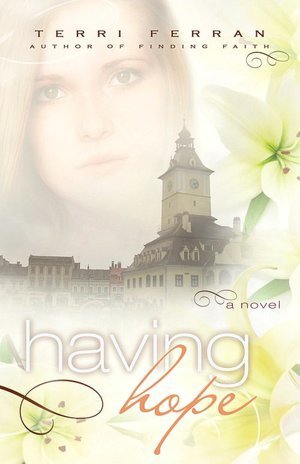 est writing advice you’ve ever received?
est writing advice you’ve ever received?
The pointy end of the pencil goes towards the paper.
Writing advice you’d give to others?
Don’t keep talking about writing, write.
Pick a character from one of your books and tell us about him or her:
Maven is the “fairy godmother” in my current manuscript—although the politically-correct term is “mentor” now. The recession has affected everyone and Maven’s day job is as a lunch lady at high school. She earns extra money from house-sitting and skip-trace (bounty hunting) work.
Maven cracks me up. Especially when she’s chugging Diet Coke from a 2-liter bottle.
What type of readers would like your book?
Readers with impeccable taste—or no taste—I get confused.
What is your favorite thing about writing?
I love it when the character comes alive and feels like a real person. Once my husband came home from work and I announced, “Guess what? Ben and Janet got engaged today!” He looked at me blankly and asked, “Who?” I reminded him that Janet was Kit’s (the protagonist in my work-in-progress) best friend. He wasn’t nearly as excited about their engagement as I was.
What process do you go through as you get a book ready for submission?
I edit a lot as I write the first draft. I used to think my first draft was practically submission-ready. Thankfully, I’ve learned to be a little more patient and re-read/edit more. My husband is always my first test reader and often reads chapters as I finish them. My oldest daughter and a few other people are my beta-readers of the finished manuscript. I revise based on their comments and trends I see in their feedback.
After those edits, I read the manuscript aloud to catch things I missed earlier, such as awkward-sounding phrases. I set it aside for a couple of weeks and start on something else before I read and edit it a final time.
I recently joined a critique group and am trying submitting the chapters as I write them. It’s the first time I’ve shared my “unpolished” work with fellow writers and it’s a little scary sometimes.
Yep, that critique group can be kind of scary. I’m actually nervous to post this blog because I’m really sure Terri could find ways to improve most of the sentences I’ve written!
You can learn more about Terri on her website. And don’t forget to comment on this and the other blogs on the tour for your chance to win all three books.
Filed under: Author Interviews





